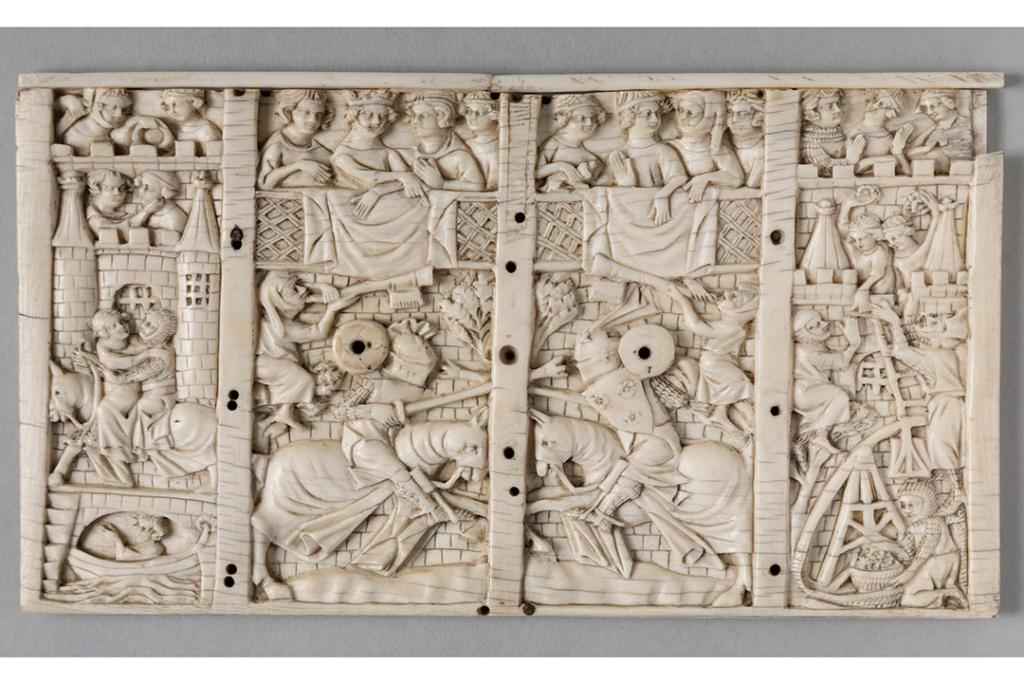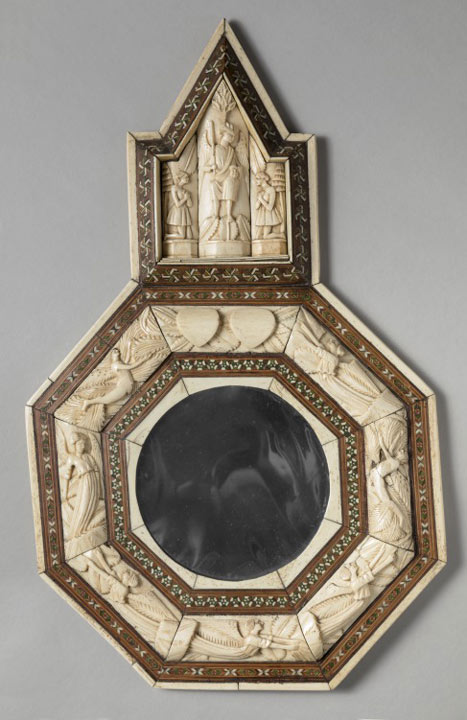Medieval and Renaissance ivories
This article is the third in a series on ivory, coordinated by National Museums Liverpool’s Ethics Group. The series considers the role and responsibilities of the organisation to display, interpret and care for the ivory within our collections, while also raising awareness of this brutal trade. In this article Pauline Rushton explains the historic appeal of ivory and the background to the objects within National Museums Liverpool’s Decorative Arts collection. The Ethics Group is made up of colleagues from across the organisation who meet regularly to review specific ethical cases or concerns, and make recommendations for action.

Since ancient times, ivory has been regarded as a precious material. Like gold, it was valued for its rarity and its aesthetic appeal. It can be worked in a great number of ways and its versatility makes it extremely attractive to the craftsman.
Early sources and uses
There are a number of different types of ivory or ivory-like substitutes. The tusks of the African elephant have always been the most highly-prized, followed by those of the Indian elephant. In Europe, the walrus is the only native source of ivory. Its tusks, known as ‘morse’, were often believed to have magical properties. Whalebone and the teeth and bones of the hippopotamus were used as less expensive substitutes for ivory during the Middle Ages. Deer antlers and horn from goats and cattle were also worked to look like ivory.
During the early medieval period, from the 5th century onwards, ivory was imported into Europe from Africa and the East via Egypt, Syria and Cyprus. It was used to make sacred objects for Christian worship, such as Bible covers, pyxes (boxes to hold the consecrated Host), reliquaries to hold the relics of saints, portable altars, crucifixes and situlae (small buckets for holy water).
A Liverpool collector
Most of the medieval ivories in National Museums Liverpool’s collection date from the late 12th century onwards, from the period that came to be known as the Gothic. The majority of them were amassed by Joseph Mayer, the Liverpool goldsmith and antiquarian whose vast collection of artefacts forms the basis of many of National Museums Liverpool’s collections today. In 1855 Mayer purchased the ivory collection of Count Gabriel Féjervary from his nephew Franz Pulsky, who had inherited them in 1851. In 1867 Mayer donated his entire collection, including the ivories, to the Liverpool Museum. No other ivories were acquired for nearly the next hundred years, until the 1950s, when several more Gothic pieces were purchased from the collection of the local antiquarian Dr Phillip Nelson. In the 1980s a couple more were purchased at auction.

Paris workshops
The majority of all Gothic ivories were carved in the area around Paris known as the Ile de France, which, from the mid-13th century onwards, became the focus for the production of sacred objects in huge numbers. Even then, the city was recognised as a centre of artistic excellence, where other European craftsmen were sent to train and acquire skills. Unlike the earlier medieval period, when such work was carried out mainly by monks in monasteries, the French craftsmen operated in small workshops, copying from previous pattern books and developing a series of standard designs. Gradually, a division of labour emerged, with some carvers making only sacred objects such as crucifixes and statues, while others made only secular items like combs, boxes and knife handles. Individual craftsmen would specialise in the making of only one type of object and no others.
Diptychs and triptychs, two- and three-leafed miniature altar-pieces, used in the home for private devotion and prayers, were a speciality of the Paris workshops. They depicted scenes from the life of Christ and his Mother, the Virgin Mary, and were originally painted and gilded in places, giving them a jewel-like quality. Most of this surface decoration has disappeared from the ivory today. There was a division of labour involved in their production, with one highly-skilled craftsman carving the figures while a less-skilled or partly-trained craftsman worked the background details.
Aristocratic patrons

From the early 14th century onwards, there was a growth in demand for secular objects, reflecting changes in patronage away from the Church and royalty and towards the growing aristocracy. The most popular objects were carved mirror cases, combs and caskets for jewellery and other small personal possessions. Many were decorated with figures of courting lovers and scenes drawn from the Romances and tales of chivalry, including the stories of King Arthur and his knights. A frequently recurring scene, especially on casket panels, is the ‘Assault on the Castle of Love’, which has no obvious literary source but probably derives from a verbal tradition rather than a written one.
During the late 14th and early 15th centuries, the production of ivory carvings around Paris gradually declined. This was due to the disruption of trade routes during the Hundred Years’ War, and also to changes in fashion as aristocratic patrons became more interested in commissioning paintings instead of smaller works of art. During the 1390s, the Embriachi family in Venice continued to produce mirror frames and caskets set with hippopotamus teeth, bone and shell, in imitation of ivory, but large-scale production of true ivory objects effectively ceased after that time.
